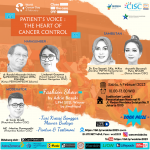LIMFOMA
Lymph nodes function as a drainage of body tissue fluids and metabolic products to blood vessels, as well as the body’s immune system to fight germs, viruses, and others.
Lymph nodes spread throughout the human body, starting from the neck, armpits, chest, abdomen, groin and knee folds.
Types of Lymphomas
In general, it is divided into 2 groups, namely Hodgkin’s Lymphoma and Non-Hodgkin’s Lymphoma. Why does it need to be distinguished? This is because the characteristics and types of treatment are different. Hodgkin’s lymphoma is characterized by the presence of Reed-Sternberg cells in the preparation
Hodgkin’s lymphoma
- The prevalence is around 15% of all lymphoma cases.
- the incidence is around 1% in the United States with 2 age peaks, namely 20-29 years and 50-60 years.
Note: Data in Indonesia does not yet exist.
Non-Hodgkin’s lymphoma
- The majority of all lymphoma cases.
- Incidence tends to increase from year to year and also according to age.
- GLOBOCAN 2018: estimated as the most cancer in Indonesia No.5 in men and the incidence No. 7 in women.
Who is at risk for lymphoma?
Those who are at risk for lymphoma are:
- Age: The older, the higher the risk
- Gender: geder Men have a higher risk of exposure than women
- Race / ethnicity: Caucasians are more susceptible
- Socioeconomic: more events occur in developed countries
- Exposure: higher risk of frequent exposure to sun radiation and chemicals
- Immune disorders: Immunocompromised or autoimmune sufferers
- Infection: sufferers or have suffered from EBV, Herpes, HIV, H. pylori, C. jejuni infection at risk of contracting
- Obesity & diet: Vulnerable if you are obese or follow a high-fat diet
Symptoms of Lymphoma
Be aware and immediately do a medical examination, if you experience the following symptoms:
- KGB enlargement (can be anywhere in the whole body).
- Stomach enlarges or feels ‘full’.
- Fever for no apparent reason.
- Weight loss.
- Tight or easily tired
Lymphoma Diagnosis
- Biopsy is the only way to make a diagnosis of lymphoma.
- Lumps suspected of lymphoma should be removed entirely to determine the type of lymphoma.
- Other causes of enlargement of the KGB (especially infection) must be removed before suspecting lymphoma.
- The removed tissue will be seen under a microscope and reacted with several chemicals by an Anatomical Pathologist (PA)
- After the diagnosis of lymphoma and its type is determined, staging the disease is carried out to see the patient’s prognosis.
- Before the biopsy is carried out radiological examinations such as: PET Scan, CT-scan, ultrasound, conventional photographs.
Lymphoma Treatment
Treatment of lymphoma is determined by the type of lymphoma and the patient’s condition. The lymphoma therapy is:
- Systemic therapy is the backbone of treatment, including:
- Sitostatics / conventional chemotherapy.
- Target Therapy
- Biological therapy.
- Immunotherapy
- Radiation can be given in certain cases, especially those that are local or involve extranodal.
- Surgery usually has no place for treatment except for life-saving or cases involving the gastrointestinal tract.
- Bone marrow transplantation. However, this therapy is still under development and recommended for cases that are not responsive to chemotherapy.
Source:
presentation paper on lymph node cancer (lymphoma) in the Training of Speakers event as a series of WORLD CANCER DAY 2019 organized by the KPKN, Ministry of Health RI, RSCM, FKUI
Lymphoma brochure (lymph node cancer) from the Indonesian Ministry of Health’s KPKN
http://kanker.kemkes.go.id/guidelines_read.php?id=4&cancer=9
POST POPULER
POST TERBARU








Comments are closed.